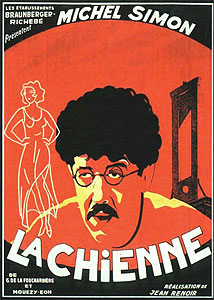Louis XVI: Pierre Renoir
La Rochefoucauld: William Aguet
Marie Antoinette: Lise Delamare
Roederer: Louis Jouvet
Bomier: Edmond Ardisson
Arnaud: Andrex
Javel: Paul Dullac
Louison: Nadia Sibirskaïa
Director: Jean Renoir
Screenplay: Jean Renoir, Carl Koch, N. Martel-Dreyfus
Cinematography: Jean-Paul Alphen, Jean Bourgoin, Alain Douarinou, Jean Louis, Jean-Marie Maillols
Production design: Léon Barsacq, Georges Wakhévitch
Music: Joseph Kosma, Henry Sauveplane
Just the film for Bastille Day. If ever a movie deserved the oxymoronic label of "intimate epic," it would have to be Jean Renoir's
La Marseillaise, a story of the French Revolution from the fall of the Bastille to the victory over the Prussians at Valmy. It's not the part of the revolution we're used to seeing, as it ends before the Reign of Terror, with its tumbrils and guillotines. Instead, it's a collection of vignettes high and low, from the king and queen blithely expecting the trouble to blow over to the foot soldiers who marched from Marseille to Paris to depose them. The director's brother, Pierre, is a wonderful Louis XVI, not quite the caricature that Robert Morley made him in Hollywood's
Marie Antoinette (W.S. Van Dyke), which was made the same year, but nevertheless more than a little out of touch: As the Tuileries is being stormed, Pierre Renoir's Louis is perturbed that he can't finish his dinner and that his wig is slightly askew. Lise Delamare's Marie Antoinette is somewhat more clued in, but her frosty hauteur suggests that she is fully capable of uttering the apocryphal "Let them eat cake." Much of the film, however, focuses on the soldiers who, after capturing the forts at Marseille, march toward Paris, and especially on Bomier, a mason who joins the regiment after putting things in order for his mother (whose tears are a familiar cinematic clue to Bomier's fate). Bomier tells his companions Arnaud and Javel that the marching song that gives the film its title is no good and will soon be forgotten, but by the time they reach Paris, he is joining in the chorus. Renoir made
La Marseillaise between two greater films,
Grand Illusion (1937) and
La Bête Humaine (1938), partly as a leftist political statement at a time when the forces of the right were triumphing on every side of France. He got his financial backing for the project from trade unions, but the film was a disaster at the box office and disappeared for a long time. It feels a little more formulaic in its characterization than Renoir's best films are and, given our knowledge of what's to come, the ending could never be quite as upbeat as Renoir seems to want it to be, but it's still the work of a master filmmaker.
Watched on Filmstruck Criterion Channel








_poster.jpg)






